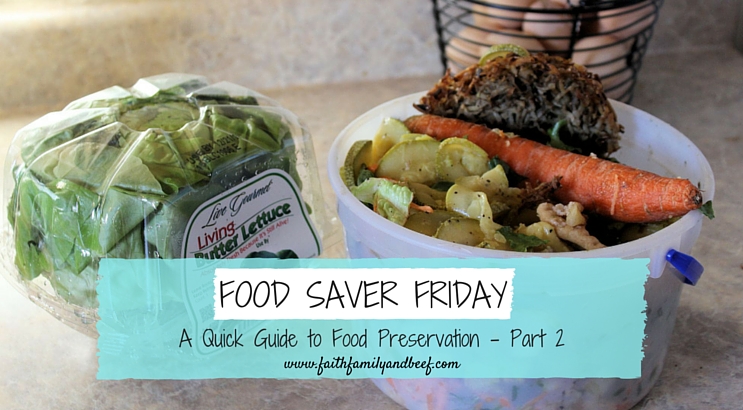Building upon what was prefaced last time, this Food Saver Friday we are going more in-depth on which foods are best suited for each preservation method and some simple techniques to set you up for preservation perfection.
A Quick Guide to Food Preservation – Part 2
Preserving is really and truly a beautifully tasty form of art – food art. Discussing all of the ways you can preserve food could fill a book. In fact, it has filled at least one book (and I am sure several more). But if you are ready to try your hand at creating perfectly preserved food art and are looking for easy-to-understand information (and recipes) beyond what I am about to cover, I highly recommend snagging a Ball Blue Book® Guide to Preserving for your very own.
For now, here is a quick overview of the ideal foods for each method and a few tips and tricks to get you started on your path to preservation.
Canning
I am learning that canning is pretty much the most universal method of preservation known to man. I mean, if it grows, you can can it – meat, fruit, veg, anything. The trick is knowing which foods play the nicest with which canning methods.
Water bath friendly.
The water bath method is meant ONLY for high-acid foods – apples, apricots, blackberries, gooseberries, lemons, peaches, pears, plums, sour cherries, tomatoes, and pretty much anything you pickle or turn to kraut. The process of pickling and making kraut drops the pH of foods typically with the addition of vinegar. The vinegar turns formerly low-acid foods into high-acid foods, making them eligible for processing in a water bath canner.
Pressure canning required.
All foods, high and low-acid, can be processed and preserved with a pressure canner. However, low-acid foods – asparagus, beets, carrots, corn, green beans, lima beans, peas, okra, spinach, turnips, etc. – require pressure canning to ensure safe long-term storage free from pesky bacteria.
Dehydrating
Dehydration is the oldest, most effortless method of food preservation. This method yields not only tasty treats that are easy to grab-and-go, but also flavorful herb seasonings and rubs – as long as you follow a few simple principles.
- Pre-treat your treats. If it’s veggies you’re dehydrating, then it’s blanching you need. Blanching decreases drying time, sets the color, and most importantly kills many of the bacteria present pre-dehydration. For fruits, dipping is the way to go. Dipping is the process of coating fruits in antioxidants such as, lemon or lime juice (I prefer this choice of antioxidant), ascorbic acid, or an ascorbic-citric acid blend, thus preventing oxidation. Oxidation is less than ideal because it not only causes fruits to brown, but also lose some of their vitamin integrity when exposed to oxygen.
- Processing your produce. Somethings like herbs, especially chives and dill, I like to simply be spread on the counter or hang upside down and air-dry. But other foods such as meats, fruits, and veggies need to be dehydrated at specific temperatures for varying amounts of time. Typically veggies are dried at 125 degrees, fruits at 135 degrees, and meats at 145 degrees. Times and occasionally temperatures do vary by food type, thickness, and recipe.
- Stretch the shelf-life with stellar storage. The only rule to storing dehydrated food is to pick a container that is air-tight and keeps food dry. My personal preference is storing my dehydrated foods in a resealable bag jar. But for longer storage, I usually opt for vacuum packaging with my handy dandy FoodSaver®.
Freezing
Most all of the same principles that apply to dehydrating also apply to freezing. But one important rule that is missing from the list above is that of cooling your prepared and packaged foods prior to putting them in the freezer. Fast freezing reduces ice crystals, preserves color, prevents spoilage and is essential to successful food freezing preservation. So making sure your food is chilled, or at least at room temperature, before it goes into the freezer is a must.
There are lots of things that freeze extremely well including herbs, as I recently learned (check out this link for more on herb freezing). But there are also a few things that are not freezer-friendly including mayonnaise, jellies, potatoes, egg whites, and speaking from experience – sour cream…
Next Time on Food Saver Friday
Ever wonder if there is anything else you can do with those old coffee grounds, pesky food scraps, or that fruit that is maybe slightly over-ripe? Well, you are in luck! Next time, we will be tackling the topic of re-purposing food scraps. In the meantime if you have questions or ideas for future Food Saver Friday topics, feel free to leave them here in the comments, or shoot me an email using the Contact Me page. And if you’ve missed any of the food saving goodness, click here to catch up.

 Hello! I’m Terryn – the wife, mother, food safety enthusiast, Stormy Kromer fanatic who has slightly (okay, a lot) random tendencies, dabbles in photography, and shares (maybe a little too much) here at FFB.
Hello! I’m Terryn – the wife, mother, food safety enthusiast, Stormy Kromer fanatic who has slightly (okay, a lot) random tendencies, dabbles in photography, and shares (maybe a little too much) here at FFB.